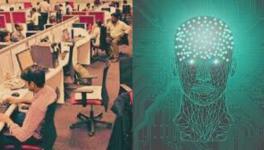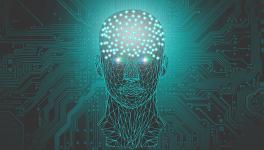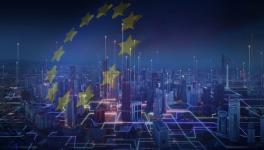Ghibli Magic vs. Our Reality: Are We Ignoring Nature’s Crisis

Image Credit: Rahul Daspattnaik
You still don’t have your Ghibli art? Really? Oh, you’re so out of trend! Then you rush to find the perfect picture to transform, spending hours searching for just the right one. But then, dissatisfaction sets in, and the quest for a better photo begins. You keep trying and trying until, inevitably, the tool politely informs you, ‘You’ve exceeded the limit.’ The struggle is real, so real.
The recent surge in AI-generated images emulating Studio Ghibli's distinctive art style has captivated social media users worldwide. This ‘Ghiblification’ trend allows individuals to transform personal photos and popular memes into visuals reminiscent of the beloved Japanese animation studio's works. While this fusion of nostalgia and technology has sparked widespread enthusiasm, it also raises significant concerns regarding energy consumption and server sustainability.
Studio Ghibli, founded by Hayao Miyazaki and Isao Takahata in 1985, is a renowned Japanese animation studio known for its exquisite hand-drawn animation and enchanting storytelling. Its signature artistic style has captivated global audiences and inspired countless artists, leading to the emergence of a distinct aesthetic often referred to as ‘Ghibli art’.
In recent years, artificial intelligence (AI) has enabled the replication of this art style, contributing to a growing trend of AI-generated Ghibli-style imagery. While this technological advancement has expanded creative possibilities, it has also raised significant concerns regarding its environmental impact, particularly in terms of energy consumption and server resource management.
The studio's dedication to traditional animation techniques, often involving thousands of individual frames, has established Ghibli art as a benchmark in the animation industry. Over time, this style has permeated popular culture, inspiring fan art, merchandise, and digital recreations.
Recent advancements in AI, particularly in the realm of generative models like DALL-E and MidJourney, have made it possible to create Ghibli-style images within seconds. Users can input text prompts to generate scenes reminiscent of Studio Ghibli's iconic landscapes and characters. This phenomenon, often termed "Ghiblification," has gained traction on social media platforms, where users share AI-generated artwork that evokes nostalgia and admiration.
AI-powered platforms leverage vast datasets to train their models, imitating the stylistic elements of Ghibli art without the need for extensive human input. While this democratises artistic expression and provides opportunities for creativity, it also raises ethical questions regarding the replication of distinct artistic styles and the potential undermining of human artists.
Indian social media users have enthusiastically embraced this trend, sharing AI-crafted Ghibli-style images across various platforms. Notably, Bollywood celebrities, such as Amitabh Bachchan, Ranbir Kapoor, Shah Rukh Khan, have participated by sharing AI-generated images from fan interactions, further amplifying the trend's reach.
The trend has also permeated public institutions. For instance, the Bengaluru City Police incorporated Ghibli-style AI images into their social media content, demonstrating the widespread appeal and creative applications of this art form within the country.
The widespread adoption of AI tools for generating Ghibli-style images has led to a substantial increase in demand on computational resources. OpenAI, the organisation behind ChatGPT, has reported that its graphics processing units (GPUs) are experiencing significant strain due to the high volume of image generation requests.
OpenAI CEO Sam Altman in his X handle acknowledged this issue, stating, "It's super fun seeing people love images in ChatGPT, but our GPUs are melting."
In response, OpenAI has implemented temporary rate limits to manage the load and ensure system stability. One of the reports published by Forbes India reveals that AI data centres, which power these image-generation tools, are known to consume substantial amounts of electricity.
In India, data centres currently account for approximately 2% of the total power consumption, a figure expected to rise with the growing adoption of AI technologies. Another report by Pure Storage highlights that 74% of organisations in India express concern over AI's impact on energy usage and its alignment with environmental, social, and governance (ESG) goals. This underscores the need for sustainable practices in the deployment of AI technologies.
The environmental implications of this increased computational demand are notable. AI data centres require substantial energy for both processing and cooling operations. As AI-generated art becomes more prevalent, the associated energy consumption escalates, raising concerns about the sustainability of such practices. Experts suggest exploring more efficient cooling methods, recycling waste heat, and integrating renewable energy sources to mitigate the ecological footprint of AI technologies.
Beyond environmental concerns, the Ghibli art trend has ignited debates over ethical and copyright issues. Zelda Williams, daughter of the late actor Robin Williams, in her interview with San Francisco Chronicle has criticised the trend, highlighting Studio Ghibli founder Miyazaki's documented opposition to AI-generated art. Miyazaki has previously expressed that AI technology is "an insult to life itself," emphasising his belief in the value of human creativity.
Legal experts question whether AI models have been trained with proper permissions from Studio Ghibli or Miyazaki's works, suggesting potential copyright infringements.
OpenAI maintains that it employs a conservative approach, avoiding the replication of specific living artists' styles while permitting broader studio aesthetics. Nonetheless, the ability of AI to mimic distinct artistic styles poses challenges to existing copyright frameworks and the livelihoods of human artists.
To sum up, the Ghibli art trend exemplifies the intersection of technology and creativity, offering users novel means of artistic expression. However, it also underscores the pressing need to address the environmental impact of AI-generated art, particularly concerning energy consumption and server sustainability. The allure of Ghibli art and the accessibility of AI-generated imagery have created a vibrant digital landscape of creative expression. However, the environmental consequences of energy consumption and server strain necessitate responsible innovation.
By adopting sustainable practices and fostering ethical AI development, the digital art community can continue to celebrate the beauty of Ghibli-style art while minimising its ecological footprint. Ultimately, the future of AI-generated art hinges on striking a balance between technological progress and environmental stewardship. Through mindful choices and collaborative efforts, we can ensure that the legacy of Ghibli art inspires generations to come without compromising the health of our planet.
The writer is Assistant Professor, Department of Sociology, Maitreyi College, University of Delhi, and Executive Editor, Asian Ethnicity. The views are personal.
Get the latest reports & analysis with people's perspective on Protests, movements & deep analytical videos, discussions of the current affairs in your Telegram app. Subscribe to NewsClick's Telegram channel & get Real-Time updates on stories, as they get published on our website.
























